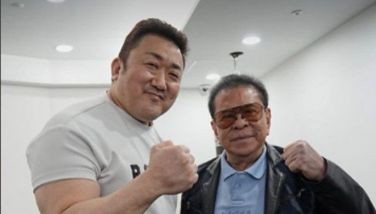Conde on the best in the Filipino
We didn’t quite expect the reception that the recent screening of Manuel Conde’s Genghis Khan would bring. The classic Filipino motion picture unearthed after 60 years in a Venetian vault was first panned by the locals at the Times Theater in Manila in 1950, then praised at the Venice Film Festival in 1952 by critics with the head of United Artists stating, “Your film echoes the best of Eisenstein.”
We can imagine Conde muttering under his breath “Sino si Eisenstein?” as his masterpiece, the first Filipino film to win international acclaim, was cited for outstanding technical achievement. A screening held in Paris in 1954 was the last heard of it. And now, restored and digitalized, Conde’s magnum opus had come home to stay.
At the reception area of SM Mall of Asia stood a huge backdrop sporting the name “Genghis Khan” in the film’s stylistic font. Soon we found ourselves surrounded by a litany of names from the film industry. We met director after director, espied director Joel Lamangan with writer Ishko Lopez, waved at Delia Razon, the most eager of the stars of Conde’s era in sharing her experiences, and greeted National Artists Eddie Romero and Abdul Imao.
Film Development Council of the Philippines (FDCP) chairman Briccio Santos, beaming from ear to ear, welcomed each visitor. His wife Peachy was helping Imao seated beside a Conde statue with a photo-op. We asked, why there? Peachy explained that Imao never had a photo with Conde when he was alive, and he wanted the next best thing now. Food and drinks appeared inexhaustible. And just when one would think the evening could not get any grander, an announcement broke the chatter requesting all to proceed to the theater as the President of the Republic was on his way.
 From left: Conde’s son Jun Urbano, FDCP’s Briccio Santos and Delia Razon
From left: Conde’s son Jun Urbano, FDCP’s Briccio Santos and Delia Razon We found our seats and after several minutes, President Benigno Aquino III speedily walked into the theater. After a few speeches by Briccio and Jun Urbano (Conde’s son), we got a fascinating account from director Davide Pozzi of L’immagina Ritrovata, the company in Bologna, Italy in charge of the restoration, on the process of frame-by-frame digitalization from the original celluloid. After Pozzi’s briefing came the official repatriation of the original reels to the Philippines into the hands of P-Noy.
As the lights dimmed and nostalgic images began to roll across a Manila big screen for the first time in over half a century, we were mesmerized by the transformation of the highlands of Angono, Rizal, where National Artist for Visual Arts Carlos “Botong” Francisco lived, into the hills of Russia where an authentic breed of extinct puny horses could be found. The audience at Times Theater had laughed at the karitela horses, but the audience abroad marveled at them. The detailed costuming by Botong was impressive; as well as the stunning strength of Conde’s performance as Timujin, the Mongolian warrior who sought to become Genghis Khan, Conqueror of Kings and Emperor of Men, and succeeded.
Like Timujin, Conde at 35, was out to show the world that the Filipino could do the same, compete with the West, using their stories and their film language, and doing them better.
We can imagine Hollywood impressed by a film brought in at P125,000 which American film critic James Agee stated as not enough money to open the gates of Hollywood in the morning. It is said Agee narrated the film in English for $1, just as Conde surrendered directorial credits to Lou Salvador for having his head shaved for the role of King Burchou, the kindhearted but feebleminded father to Elvira Reyes as Lei Hai, Conde’s love interest. Inday Jalandoni played Conde’s mother and tower of strength.
 Games of rolling boulders will prove who is the best in a scene from the film
Games of rolling boulders will prove who is the best in a scene from the film The original reels are now headed to the National Film Archives of the Philippines (NFAP) with temporary home in Cubao containing about 10,000 audio-visual elements. As the numbers grow through partnerships and active searches abroad, Briccio believes that the repatriation of Genghis Khan will send a strong signal as impetus for other foreign archives to turn over Filipino titles in their collections. Genghis Khan is testimony to the nature of the Filipino movie industry, that even if resources are limited, aspirations are limitless. Briccio told us that the film’s restoration cost about P1M. However, he said, “It’s not a monetary thing. It’s our culture. This is our heritage. We are like sleuths, detectives going around the world looking for our treasures.”
The restored Genghis Khan movie was screened during retrospective of 10 rare restored films at the recent Venice Film Festival. After its Manila premiere, it goes to the Museum of Modern Art (MOMA) in New York to participate in its To Save and Project: International Festival of Film Preservation come Oct. 12 and 17. It returns home on Oct. 20 for Home Movie Day at the UP Film Institute and World Day for Audiovisual Heritage on Oct. 27.
(E-mail us at [email protected])
 National Artist Eddie Romero flanked by wife and son
National Artist Eddie Romero flanked by wife and son - Latest
- Trending































